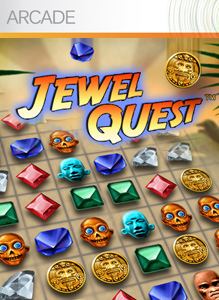5.8 /10 1 Votes5.8
Distributor(s) Various Initial release date 14 July 2004 Developers iWin.com, Alawar | 2.9/5 IzzYGames Series Jewel Quest | |||||||||||||||||||||||||||||||||
 | ||||||||||||||||||||||||||||||||||
Release date(s) PCOctober 29, 2004Mobile phoneMay 17, 2005Xbox Live ArcadeMarch 8, 2006 Platforms Microsoft Windows, iOS, Macintosh operating systems, Xbox 360 Publishers iWin.com, Alawar, MacPlay, CTXM Ltd. Similar iWincom games, Puzzle video games | ||||||||||||||||||||||||||||||||||
Jewel Quest is a tile-matching puzzle video game created and published by iWin. First released for PC, it has been redeveloped for Symbian S60, the Nintendo DS (Jewel Quest: Expeditions), the Xbox 360's Xbox Live Arcade and other platforms. iWin also released a series of sequels and spin-off games.
Contents
- Jewel quest island escape video walkthrough
- Basic match 3 puzzle
- Story
- Quotes
- Scoring and lives
- Games
- References
Jewel quest island escape video walkthrough
Basic match 3 puzzle
Jewel Quest is a 'match 3' puzzle played on a grid filled with various tokens, such as diamonds, gold nuggets, coins, and skulls. The player may swap any two adjacent tiles, as long as the swap results in a horizontal/vertical line of three or more matching tokens. The matched set disappears, allowing tokens to drop into the gaps from above; if more matched sets form as a result, they disappear as well.
Whenever tiles disappear, the background grid positions turn gold. The player must turn every square on the board to gold in order to complete the level. Failing to do so within the given time limit, or reaching a situation in which no more swaps are possible, costs one life and sends the player back to the start of that level.
As the game progresses, new variations are introduced to make gameplay more difficult: irregularly shaped grids, squares in hard-to-reach places, tokens that must be matched multiple times to clear them from the board, and so on.
Story
Jewel Quest has 180 levels and is set within the Mayan culture. There are 36 grids and they are played through, in succession, five times, with each play-through adding a new level of difficulty. During the first run-through, "Explorer," the player is given pieces of storyline in the form of "journal entries" to read after completing each grid, with an additional snippet before the beginning of each level. After playing the 36th grid, the totem "speaks" as well there being a written blurb. After the "Explorer" level, new information is given only at the end of the 36th level, and once after playing the 1-2 grid during the second run-through. All other "journal entries" are quotes or sayings to encourage the player. Likewise, if the player fails to complete a level within the time frame, encouraging quotes will be used.
Quotes
"Truth, like gold, is to be obtained not by its growth, but by washing away from it all that is not gold." - Tolstoy
Jewel Quest II has 180 levels, and after each level you advance along a map representing a journey in Africa. Additional Jewels were added. Again, there are 36 boards to play, with each play-through increasing in difficulty. For Jewel Quest II, the boards are not necessarily the same as in the previous play-through. Also, while in Jewel Quest I, blank squares are obstacles, the player is allowed to move jewels into empty squares in the grid in Jewel Quest II, introducing new strategy. The player's character is revealed to be named Rupert, and the story revolves around him searching for a "Golden Jewel Board" in Africa, as well as a romantic subplot with a woman named "Emma" and a villain named "Hani." Emma and Hani each receive their own first-person text entries for an entire play-through, though the final play-through is done by Rupert. The background reflects the location of the characters within the story.
Jewel Quest III's levels range throughout the world. The new Globe interface allows you to select from different regions to play. Mexico, Iceland, Europe, Africa, South America, Australia, China, Alaska, East Asia are the regions. In each region there are several locations to choose from and each level has multiple passes. New to JQ3 is that some of the jewels have special properties.
Scoring and lives
When you match a set of tiles, you gain points based on the number of tiles matched and the number of "cascaded" matches that have occurred. "Cursed" black tiles appear in later levels; directly matching a set of these deducts points and erases the gold behind them. However, the cursed tiles can be safely removed as a "cascaded" match.
When you run out of time on a level, or reach a point where there are no moves possible, you lose a life and must start the level over.
You are granted an additional life for every 50,000 points earned.
Games
The Jewel Quest series has evolved since its beginnings starting with Match 3 to Playing Cards and Hidden Objects. Also starting on the computer and moving to consoles and mobile devices.
